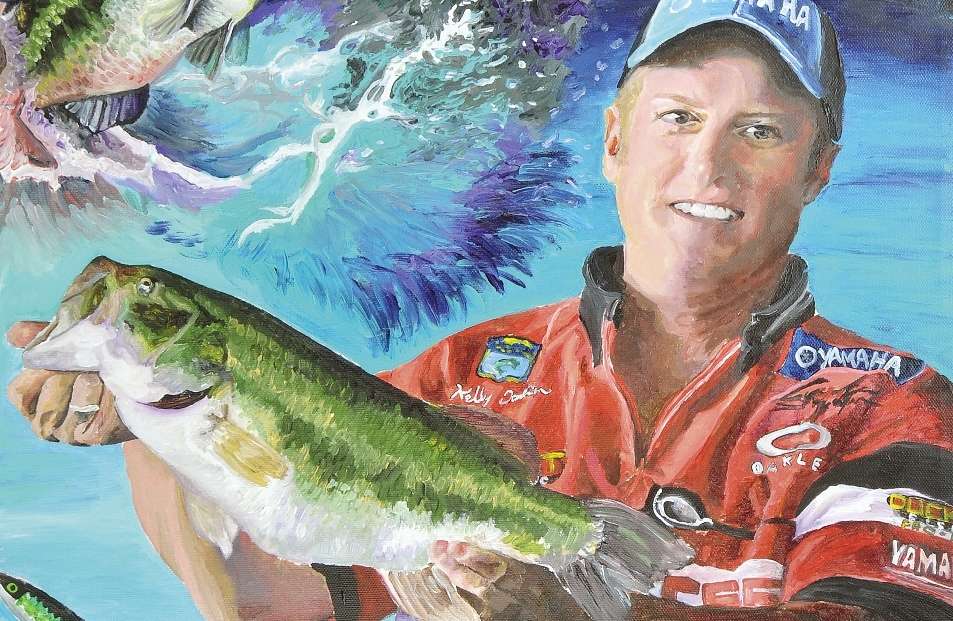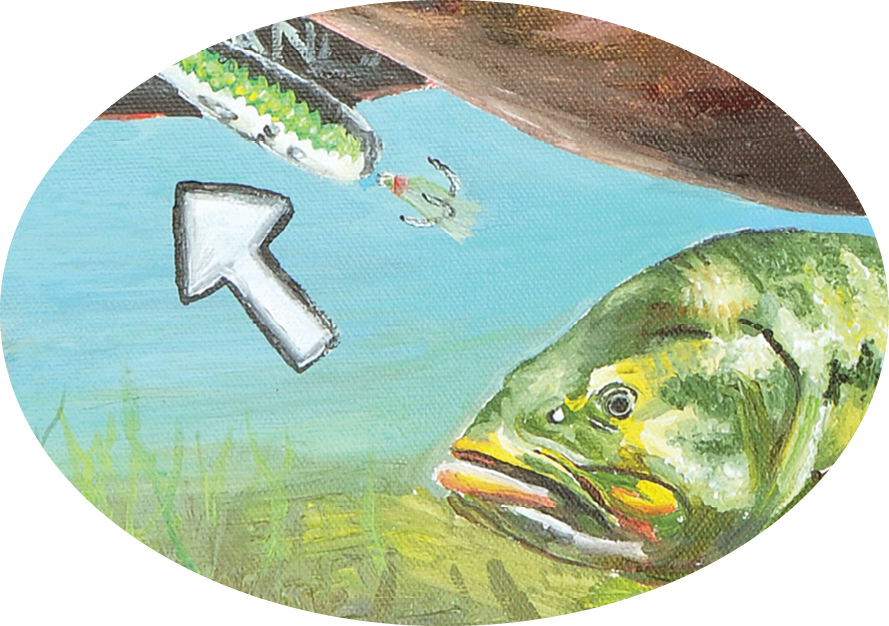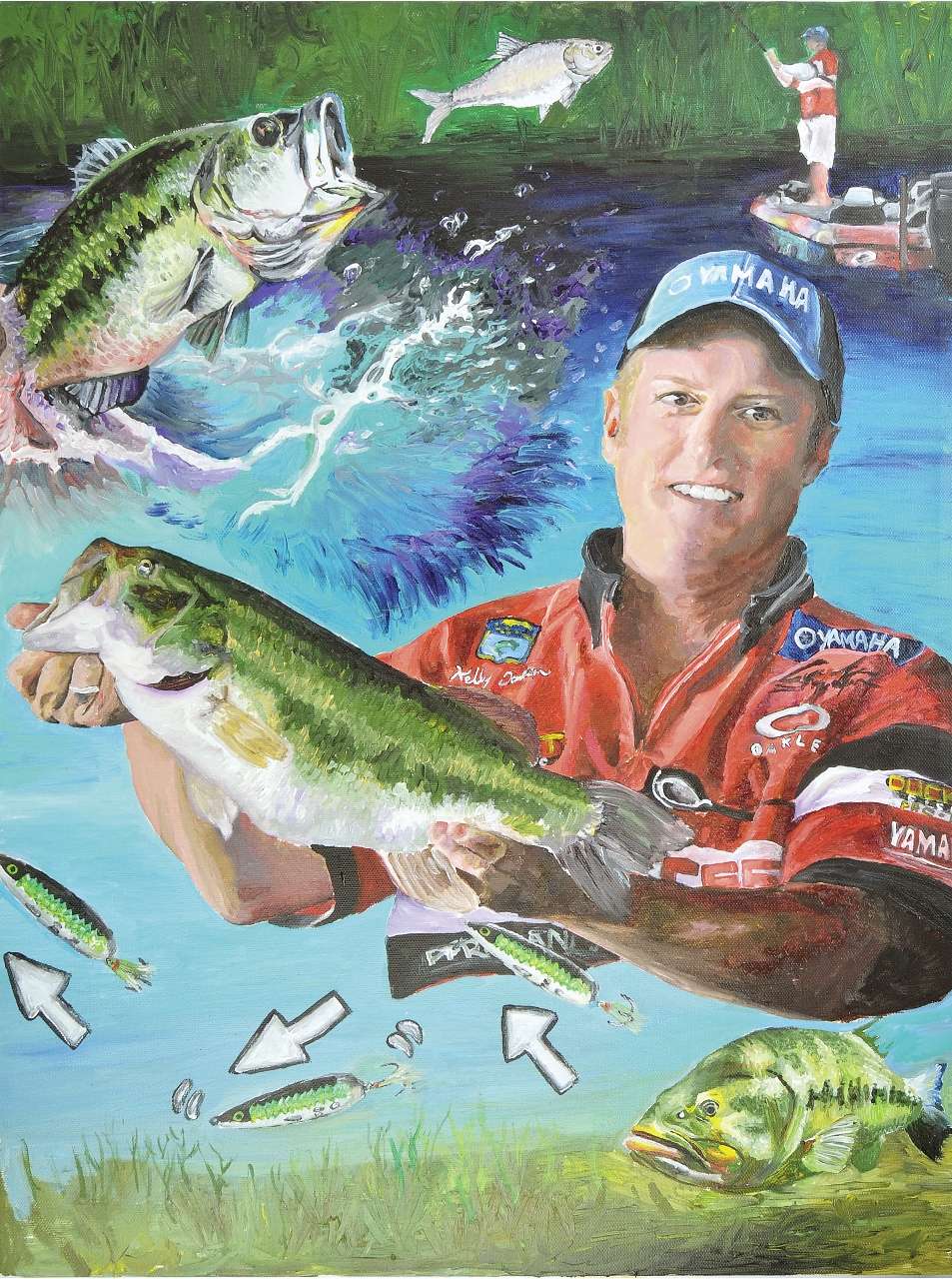
To be sure, fishing a 2-ounce, 6-inch hunk of metal can be intimidating. Still, there is a time and place where giant flutter spoons will be the best option for catching deep-water bass. Elite Series pro Kelly Jordon has spent more than a decade perfecting the art of eliciting bites with the oversized lure. Embrace his system, and there is little doubt you’ll be making room in your tacklebox for this heavy metal
If, per chance, you have included Texas’ Lake Fork on your Bass Fishing Bucket List, make sure you add a special note to aim a few casts just north of the 515 bridge, not far from Lake Fork Marina. Idle over the river channel a few times before you start, so you can get an idea of what’s down below. The majority of Lake Fork visitors don’t realize there is an old roadbed and another bridge about 25 feet deep right there. Most months of the year, there are plenty of bass suspended on it, too.
The best way to catch them is with a big flutter spoon, preferably a 6-inch, 1 1/2-ounce Big Joe Flutter Spoon (silver with a chartreuse stripe) made locally by longtime lure creator Joe Spaits. That’s the lure Bassmaster Elite Series pro Kelly Jordon had tied on when he visited the underwater bridge one summer afternoon more than a decade ago. As a guide on Lake Fork, Jordon of course knew about the bridge, but it was his first time to throw a Big Joe spoon. Counting it down, he caught 15 bass, all between 4 and 6 pounds, on his first 15 casts.
Jordon has been a devoted spoon fisherman ever since, and in fact, he is the angler credited with bringing big flutter spoons into the national spotlight. That happened shortly after the 2006 Bassmaster Elite tournament on Kentucky Lake. Jordon didn’t win that event (Morizo Shimizu did), but he did finish 11th, after boating 19 pounds of bass with the spoon on six casts the first morning. Catches like that do not go unnoticed among the tournament pros.
“The beauty of a big flutter spoon is that it allows you to fish deeper water faster and more effectively than any other type of lure,” explains Jordon, a four-time winner on the Bassmaster Tour. “It imitates a dying baitfish, or a baitfish being chased, depending on how you fish it, but whatever you do with it, a big spoon seems to trigger a bass’ predatory response because of its erratic action and flash.”
Jordon, like so many bass fishermen, already had years of spoon fishing experience before that special afternoon above the 515 bridge, but all of them had been with much smaller lead jigging spoons, a standard winter lure on Fork. He’d even known Spaits for years before ever using one of the Big Joe spoons, since Spaits also custom-made a special night fishing spinnerbait for him.
Spaits, now 70 and still an avid bass fisherman himself, takes no credit for inventing big flutter spoons. He’d been fishing down by the dam on Lake Fork one day when he saw a big 12- to 14-inch gizzard shad jump out of the water, immediately followed by a bass at least twice that long. Nothing in his tacklebox remotely approached the size or appearance of that shad, so Spaits started shopping around, eventually settling on brass flutter spoons.
Brass provides much better action than the more commonly made lead flutter spoons, falling more slowly but still with plenty of fluttering movement. It also swims better on retrieve. Spaits orders them in 5-, 6- and 7-inch sizes and with both gold and silver plating, then finishes them with split rings and a Mylar-covered VMC treble hook. Orders to his supplier have steadily grown to more than 2,000 a week as anglers nationwide discover the big spoon’s effectiveness.
“A lot of lures — like worms, jerkbaits and swimbaits — are made in large sizes, and there are reasons why they are so effective,” Jordon continues. “First, big lures do catch big bass. There is no denying that. Secondly, a larger lure looks different from the smaller lures bass are more accustomed to seeing, so it gets their attention. And third, larger lures increase the size of the strike zone because they’re visible from a greater distance.
“Joe makes his Big Joe spoons that weigh up to 2 ounces, but both Nichols and Profound Outdoors produce even heavier 8-inch flutter spoons. Joe’s spoon was not a new lure, because Northern fishermen had been using oversized spoons for years to catch giant pike and muskie, but no one ever thought of using a 6-inch flutter spoon on Fork, or for big bass in general, until Joe started doing it. Fork, especially, with its thousands of acres of shallow brush and vegetation, is certainly not a typical spoon-fishing lake, which to me just demonstrates how deadly a big flutter spoon really is.”
Jordon’s favorite time to fish a big flutter spoon is during the summer when bass typically gather in large schools on, or close to, structure, but he’s quick to add that these lures are productive throughout the fall and winter, as well. The only time they’re really not a lure of choice is during the spring spawning season when bass are bedding, but they can be used during the early prespawn and again during the postspawn when fish are in slightly deeper water.
“Because of its weight and size, and because most strikes come as the lure is falling, these spoons are hard to work in shallow water,” Jordon says. “That’s why I don’t use spoons in the spring, but it does work well in 10 feet of water and deeper. At Lake Fork, I have caught bass with spoons down to 45 feet, and there’s no question they can be fished deeper. In that Elite tournament on Kentucky Lake, I was fishing ledges 20 to 25 feet deep, which was pretty much uncharted territory in those days, because everyone else concentrated in water just 10 to 12 feet deep.
“A lot of times, you’ll find a school of deepwater bass on your electronics but you can’t get them to bite,” he says, “but once you do, you have to get them into the boat as fast as possible to keep them biting, and a big flutter spoon lets you do that better than any other lure. It will usually catch the largest bass, too, even if you’ve already caught some with Carolina rigs, crankbaits or even swimbaits.”
Jordon’s first cast with a spoon is nearly always the same, regardless of the time of year. He makes a long cast, lets the lure hit bottom, then begins retrieving with very short hops. If he knows bass are present, this retrieve will tell him how aggressive the fish are. These short hops, moving the spoon just 6 to 12 inches off the bottom, still provide plenty of action, and even if bass are suspended farther above the bottom, they’ll still swim down to hit the spoon.

This presentation also keeps the spoon in a productive area longer than jumping the spoon farther off the bottom with a big ripping action with his rod. In the winter months, Jordon simply slows the cadence of his hops, letting the spoon lie motionless on the bottom; he’s had bass literally pick up the spoon while it is on the bottom like this.
“In the summer and fall, I try the short hop retrieve for several casts,” adds the Elite pro, “but if I don’t have any response, then I will rip the spoon up off the bottom, because it’s usually effective in getting a school of bass fired up, or if I know they’re suspended 5 or even 10 feet above the bottom. Because these spoons weigh so much, you can really jump them up off the bottom with a hard jerk of your rod.
“To me, the best scenario is when bass are just a foot off the bottom, because they’re nearly always more active and will hit the short hop presentation. Generally, if you see bass as much as 5 feet above the bottom, they’re pretty neutral and are much harder to catch. That’s when you need to use a hard ripping action that brings the spoon up to them.”
Another presentation Jordon uses, especially when bass are suspended even higher off the bottom, like they were around that sunken bridge, is what he terms his burn-and-kill retrieve. It’s how he often fishes a big swimbait: counting the lure down, then reeling fast to make the lure start its fluttering, swimming action, then stopping so the spoon suddenly begins sinking like a dying baitfish. After a moment’s pause, he starts reeling again, then stops once more. The advantage of the Big Joe’s brass construction is that the spoon keeps fluttering at virtually any speed, whether it’s falling or swimming.
“These types of spoons do not work well when fished vertically, the way you fish other spoons,” Jordon cautions. “They are made with a curved type of concave face, so they flutter. That’s why you make longs casts with them. I use 17- to 20-pound fluorocarbon line and a 7-foot, 6-inch medium-heavy White Ice Duckett Rod that I designed for spoon fishing. It has the length to make long casts [and] the backbone to handle these heavy spoons, but a soft tip to help me hop or rip the spoon.
“Depth control is extremely important when you’re targeting suspended bass, which you are so much of the time with flutter spoons. When I’m counting down my spoon, I want the lure to fall through the fish so that when I rip it up, it actually jumps back above them. Suspended bass like this will come up to hit a lure much easier than they go down to hit it.”
Jordon advises anglers first learning to fish one of these lures to carefully learn how fast the lures fall. The easiest way to do this is to find water that is about 20 or 25 feet deep, make a cast and count how long it takes the spoon to reach bottom. It won’t be 1 foot per second, as it is for many smaller lures; the length of time it takes your big flutter spoon to reach the bottom in 20 feet can then be calculated for other depths.
It took months for Spaits to decide on the size, weight and design of his spoon, and even after he had made his decision, he hesitated to put them up for sale because he wasn’t sure bass fishermen would buy them. Then, one Friday afternoon, he recalls, two Dallas-area fishermen came into his shop (The Tackle Factory in Alba; 903-765-3398) and very skeptically each purchased one spoon.
On Monday morning, his phone started ringing. The Dallas anglers had had the best Lake Fork fishing trip of their lives, and they ordered a dozen more Big Joe spoons. Five minutes later, another fisherman called and ordered even more of them. He’d caught an 8-12 on his very first cast with the spoon, and an 8-14 on his second cast.
One of the most frequently asked spoon-fishing questions Jordon receives has to do with snagging the lure on bottom cover, and the answer is that the majority of the time he can shake the lure loose by positioning himself right over it. The weight of the spoon itself helps free it; the only times this doesn’t work is if the spoon gets wedged in rocks or if he hooks a rope or old trotline. In all his years of fishing these big flutter spoons, Jordon remembers losing only three or four of them.
“Spoons are not that effective around vegetation, either,” Jordon says, “simply because other lures come through that type of cover more efficiently. You can fish a Big Joe spoon around the edge of a hydrilla line, but [Rat-L-Traps] or weedless soft plastics are much better choices.
“Essentially, big flutter spoons produce the best when you’re fishing ledges, humps and other underwater structure in a little deeper water. When bass are close to the bottom and you’re having trouble feeling or controlling a lighter lure, like a jig or Carolina rig, a big spoon will out fish them almost every time, and for suspended fish, there is probably not a better lure made.”
Especially when they’re suspended off that old bridge and sunken roadbed just north of the 515 bridge on Lake Fork.
“To me, the best scenario is when fish are just a foot off the bottom … [they] will hit the short hop presentation.”
Originally published in Bassmaster Magazine Nov/Dec 2015.





